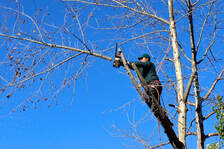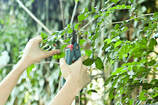 There is more to tree trimming and pruning than removing a branch here and there. It is part science and part art that encourages aesthetics and health for your trees. With proper trimming or pruning, you lessen the risk of tree damage to your property. If there is a need for you to maintain the look and health of your tree through trimming and pruning, the next question is how much should you allot for this project? The good thing is, your reputable tree company has a way to determine the accurate pricing for trimming, pruning, and branch removal. How to Determine the Cost for Tree Trimming and Branch Removal Tree trimming is not something you can put a price tag on. To get an accurate quote, you should consult a certified arborist so he can assess the tree to be trimmed. Only then can he give you the right estimate for the job. What is the Cost to Trim Trees There are a number of factors to be considered to come up with the cost of tree trimming. The following are the critical factors to look into to determine the pricing for trimming: Tree Type: Trees vary in shape and sizes. Trees that are larger and have more extensive canopies will take more time and effort to prune. Smaller trees, on the other hand, are much easier to handle and may cost less. Location: Before trimming a tree, it is essential to consider the site including the neighborhood. Arborists will also look at what surrounds the tree before deciding on the cost. If your tree is located near the street, it may cost more to remove it because the road needs to be secured first. It will also cost much if the tree is too close to your home because it will require the use of more human resources and equipment. Arborists will have to make sure surrounding properties are safe before starting the tree removal or trimming. Client Needs: Arborists will give expert advice as to what the tree needs. They can tell you whether the tree needs trimming or if it needs to be removed. More than that, they will also consider the client's special requests to come up with the right price. When arborists come to your property, they don't just lay the amount on your table. They will provide you with options and will ask you what exactly you want to do to your tree. Do you want to clean the canopy or remove dead branches? Simply put, arborists will take into account your desires while taking care of your tree. Time Requirement: Another factor to consider is the timeline needed to finish the job. Some trees require a longer time to trim or remove than others. Larger trees usually take more time and effort to cut or remove than smaller ones. They also require the use of heavy equipment and more workforce that can drive up the cost.  A certified arborist can make a challenging task look like a walk in the park. When you watch your arborist perform tree maintenance, it is easy to think that he is doing a simple job, but what you don't know is that he is actually adhering to the strict standards set by the American National Standards Institute for tree pruning. Following the standards set by ANSI distinguishes a certified arborist from an amateur. There are no shortcuts when it comes to correct tree pruning. You have to be keen on every detail, measurement, and technique to ensure you are doing the work right. If you fail to follow even a simple rule in pruning, you can cause grave damage to the tree if your arborist is unaware of what the standards by ANSI A300, think twice in hiring him. The ANSI A300 ensures that arborists can treat and safeguard the overall welfare of the tree through pruning. Trees are living things that need proper care to thrive. An arborist should be able to help trees grow to their full potential and prevent them from causing trouble for the homeowners. There are dos and don'ts when it comes to tree pruning, and it is essential that they are followed at all cost to keep the tree in a healthy condition. If you prune a tree that doesn't need pruning, you may be endangering its health, rather than helping it. We have a summary of the standards for tree pruning set by the American National Standards Institute: Pruning Dos We have mentioned it before, and we will say it again for emphasis: Ask if your arborist knows and follows the standards set by ANSI. Be wary of companies that will answer yes, but don't know what you are talking about. It will help if you ask the name of the standard to check if they are telling the truth. The standards set by ANSI are straightforward and clear. From the tools to be used down to the techniques to be performed, everything is discussed in ANSI A300. When giving an estimate, it is essential that the tree company follows the definitions indicated in ANSI A300. If they don't follow the outline, they may give you an inaccurate estimate. When the process of pruning started, there is no way you can undo it. If you cause damage to it, no matter how simple or grave it is will impact the health of the tree. In most cases, if the damage is excellent, the lifespan of the tree can be affected. Cutting the tree too deeply can also attract multitudes of insects that can start the decline in the tree's health. Further, pruning should be considered after a storm, especially if some loose limbs or branches can threaten your safety. Don't try to do it on your own because you might get yourself hurt in the process. Call a local tree service to do a full assessment of the tree. Even minor damage can cause significant troubles that is why it is better to leave the job to the experts. Pruning Don'ts Just because we said, your tree needs regular pruning doesn't mean your arborist has to do it every time he does his inspection. You shouldn't treat a wound that is not there, and the same applies to tree pruning. If the tree is healthy and there are no branches that need to be trimmed, leave the tree alone. A tree on its first year of growth doesn't require pruning unless there are dead and broken branches to be removed. Also, if your tree is near a power line, it is highly recommended that you ask help from a tree expert to perform pruning safely. You shouldn't try to prune your trees just because you have a chainsaw and a ladder in the garage. Even the utilization of the equipment needs knowledge and experience, so if you don't have both, better let an arborist do it. When pruning, it is crucial to remove branch stubs without causing damage to the core of the tree. Don't use climbing spikes because they can cause damage to the tree. Also, unlike what others think, wound paint sometimes do more harm than good. The tree has its natural way of healing, so let it take its course. If you want to be confident that your trees are well taken care of, ask assistance from a reputable and trustworthy company in your local area. Schedule a consultation and get a free estimate for the job to be done. |
|
|

 RSS Feed
RSS Feed